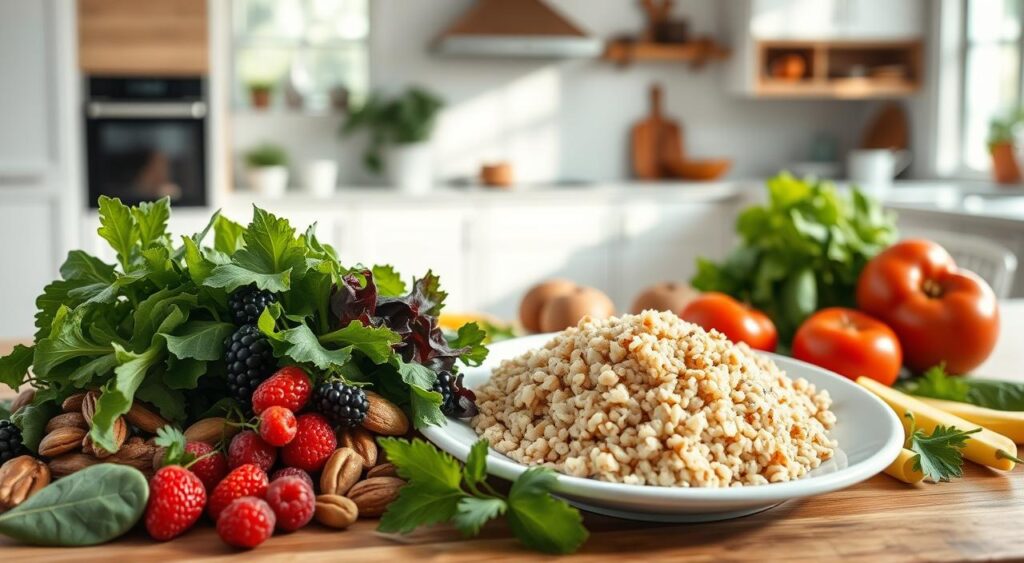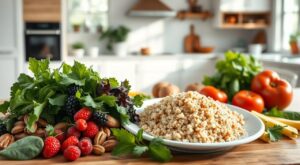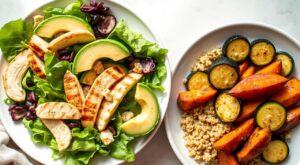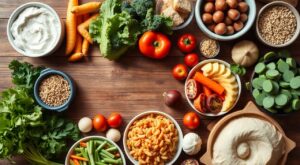Could a few smart food swaps and small daily habits really cut your risk of type 2 diabetes by more than half?
Insulin is the hormone that helps turn your meals into energy. When cells stop responding well, you get insulin resistance. This leads to higher blood sugar and a greater chance of prediabetes or type 2 diabetes. The good news is that lifestyle changes work: diet, exercise, better sleep, and modest weight loss all help.
This article is a friendly how-to guide. You’ll get an easy insulin resistance diet framework and practical tips. It’s a simple insulin resistance weight loss plan you can follow. Think of it as a realistic insulin resistance meal plan that fits your life—not a crash diet.
Throughout the guide, you’ll find evidence-based steps you can try today. Plus, when to ask a Registered Dietitian Nutritionist or your doctor about supplements like chromium or berberine. Ready to learn ten rules that actually make a difference? Let’s start.
Understanding Insulin Resistance
Ever wondered about insulin resistance and its impact on your health? It’s when your cells don’t respond well to insulin. This makes your pancreas work harder, leading to high blood sugar and possibly diabetes.
What is Insulin Resistance?
Insulin helps move glucose into your cells for energy. But with insulin resistance, this process slows down. Your body keeps making more insulin, which can harm your pancreas and raise your blood sugar levels.
Foods that quickly raise blood sugar, known as high-GI items, can make things worse. Eating them too often can lead to poor blood sugar control.
Signs and Symptoms to Watch For
Symptoms of insulin resistance can be hard to spot. You might notice more belly fat, cravings for sweets, or feeling tired after eating. Your doctor might find high blood sugar or abnormal test results before you notice anything.
Things like chronic stress, poor sleep, not exercising enough, and too much belly fat can increase your risk. Changing these areas can help manage insulin resistance.
How It Affects Your Health
If you don’t address insulin resistance, you’re at higher risk for type 2 diabetes and heart disease. Blood sugar swings can damage your blood vessels and metabolism. Catching it early through tests can help you take action.
Changing your diet is key. Eating foods with a lower glycemic index, balanced meals, and steady carbs can help. Adding sleep, managing stress, and exercising also improve insulin sensitivity.
Here are some quick tips to manage insulin resistance: eat whole foods, choose fiber and lean protein, exercise for 30 minutes daily, and get enough sleep. Small changes can make a big difference in controlling your blood sugar.
The Role of Diet in Managing Insulin Resistance
The foods you eat greatly affect how your body handles insulin. Eating whole, unprocessed foods helps keep your blood sugar stable. Making small changes to your diet can lead to big improvements over time.
Why Food Choices Matter
Your diet impacts insulin release, inflammation, and gut health. Foods high in fiber slow down glucose absorption, improving insulin action. Switching to whole grains and adding veggies helps control cravings and aids in weight management, as advised by the American Diabetes Association.
Eating lean protein at each meal helps keep blood sugar levels steady and reduces the need for snacks. Healthy oils like olive and sunflower oil support heart health without causing blood sugar spikes. Cutting down on sugary drinks, refined snacks, and processed foods also helps manage blood sugar levels.
Key Nutrients to Focus On
Fiber is essential for managing insulin resistance. Foods like oats, beans, and fruit provide soluble fiber, which feeds good gut bacteria and enhances insulin sensitivity. Aim for a variety of soluble and insoluble fiber in your meals.
Include lean proteins like poultry, fish, eggs, and low-fat dairy to slow down carbohydrate absorption and support muscle health. Unsaturated fats from olive oil, avocados, and nuts also help reduce harmful lipid shifts associated with insulin resistance.
Some minerals and compounds may support metabolic health. Magnesium and chromium are important for glucose handling. Bioactive compounds in cinnamon, turmeric, ginger, garlic, and green tea (EGCG) may also offer benefits. Always consult with your healthcare provider before adding any supplements to your diet.
| Focus | Examples | Why It Helps |
|---|---|---|
| High-fiber carbohydrates | Steel-cut oats, barley, lentils, beans, apples | Slow glucose rise, support gut microbiome, improve sensitivity |
| Lean protein | Skinless chicken, salmon, Greek yogurt, eggs | Stabilizes blood sugar, supports lean mass |
| Healthy fats | Extra virgin olive oil, avocado, almonds | Reduces inflammation, supports heart health |
| Non-starchy vegetables | Spinach, broccoli, peppers, zucchini | Low-calorie volume, high micronutrients and fiber |
| Targeted support | Magnesium-rich leafy greens, cinnamon, green tea | May aid glucose control when used with lifestyle changes |
Create a balanced meal plan for insulin resistance with whole foods, fiber, lean protein, and healthy fats. If you’re considering supplements, discuss them with your healthcare provider to ensure they meet your needs and don’t interact with medications.
Foods to Embrace
Choosing the right ingredients can change how your body handles blood sugar. Start by filling half your plate with low-calorie, nutrient-dense vegetables. This simple swap makes many of the best foods for insulin resistance easy to include every day.
Leafy Greens and Non-Starchy Vegetables
Dark leafy greens like spinach, kale, and Swiss chard deliver vitamins, minerals, and fiber with very few calories. Fresh is best, but frozen without added salt or fat works when fresh produce is out of season.
Round out meals with non-starchy choices such as broccoli, Brussels sprouts, asparagus, peppers, tomatoes, mushrooms, and green beans. These vegetables keep you full and slow glucose absorption, which makes them staples in practical insulin resistance recipes.
Whole Grains vs. Refined Carbohydrates
Swap white bread, white rice, and regular pasta for intact whole grains. Brown rice, quinoa, oatmeal, bulgur, and whole wheat pasta release glucose more slowly and add fiber. Aim for a quarter of your plate to be healthy carbs.
Sample portions help you plan: one cup cooked brown rice or whole wheat pasta, one cup cooked beans, or one to two slices whole wheat bread. Choosing high-fiber cereals and popcorn can keep your meal plan for insulin resistance varied and satisfying.
Healthy Fats to Include
Pick unsaturated fats like extra-virgin olive oil, avocado, nuts, and seeds in controlled portions. Fatty fish such as salmon and sardines offer omega-3s that support heart health and may help lower insulin resistance when they replace saturated fats.
Use fats sparingly because calories add up quickly. A teaspoon of olive oil has about 45 calories, so measure dressings and cooking oil. Building meals around vegetables, whole grains, lean protein, and measured healthy fats helps your meal plan for insulin resistance stay balanced and sustainable.
Try simple combinations in your routine: a large salad with spinach, chickpeas, olive oil, and grilled salmon; oatmeal topped with berries and flaxseed; a brown rice bowl with roasted non-starchy vegetables and turkey or tofu. These easy ideas turn the best foods for insulin resistance into tasty, repeatable insulin resistance recipes.
Foods to Avoid
To keep your diet on track, pay attention to what you remove from your plate as much as what you add. Cutting back on certain foods can lower blood sugar spikes and ease your pancreas’s workload.
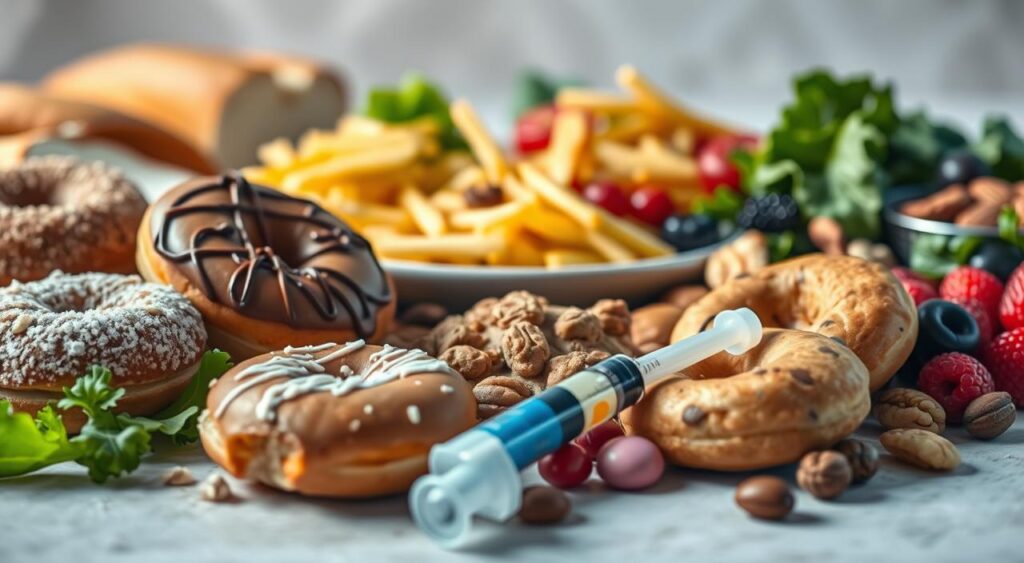
Start by cutting down on sweets and processed foods with added sugars and refined grains. Avoid candy, cookies, cakes, white bread, white rice, white pasta, and many packaged snacks. They cause blood sugar to rise quickly. Also, sweetened drinks like sodas, fruit drinks, and iced teas are bad because you can drink a lot of calories fast.
Sugar and Processed Foods
Switch to water, unsweetened tea, or green tea instead of sugary drinks. Choose whole fruits over fruit juice or dried fruit most of the time. Always read labels and avoid products with sugar listed first.
High Glycemic Index Items
High-GI foods like white potatoes, chips, and many breakfast cereals increase insulin demand. For steadier energy, choose lower-GI options like sweet potatoes, steel-cut oats, or brown rice. These choices help manage blood sugar swings and support weight loss.
Trans Fats and Their Impact
Trans fats are linked to poor insulin sensitivity and inflammation. Avoid baked goods, doughnuts, fried fast foods, and some packaged snacks with partially hydrogenated oils. Always check ingredient lists and avoid products with these oils.
Here are some easy steps to start:
- Replace soda with sparkling water or unsweetened iced green tea.
- Choose whole-grain bread and pasta instead of white versions.
- Snack on fresh fruit, nuts, or plain yogurt instead of cookies or pastries.
- Read labels for added sugars and trans fats and choose whole-food options.
| Food Category | Examples to Avoid | Smart Alternatives |
|---|---|---|
| Sugary Drinks | Soda, sweetened fruit drinks, bottled iced tea | Water, unsweetened tea, sparkling water |
| Refined Carbs | White bread, white rice, pastries, many cereals | Whole-grain bread, brown rice, steel-cut oats, quinoa |
| High-GI Snacks | Chips, fries, crackers made from refined flour | Roasted chickpeas, nuts, vegetable sticks with hummus |
| Trans Fat Sources | Doughnuts, some baked goods, fried fast foods | Homemade baked goods using olive oil or butter sparingly, grilled proteins |
Use these tips for managing insulin resistance when you shop, cook, and eat out. Small, steady changes make your meals satisfying and support weight loss and better health in the long run.
Building Balanced Meals
Creating balanced plates helps manage blood sugar and keeps you full. Use a simple guide that fits your daily life. This makes following a meal plan for insulin resistance easier and keeps portions right.
The Plate Method: A Simple Guide
Fill half your plate with non-starchy veggies like spinach, broccoli, and bell peppers. One quarter should be lean protein, such as grilled chicken, salmon, or lentils. The last quarter is for high-fiber whole grains or beans, like quinoa or black beans.
This split balances fiber, protein, and healthy fats to avoid blood sugar spikes. You can build insulin resistance recipes around this template. Swap ingredients to keep meals varied and fun.
Importance of Portion Control
Portion control keeps calories and carbs in check. Aim for about 3 ounces of cooked meat, poultry, or fish per serving, or 1 cup of low-fat cottage cheese. For grains and beans, use roughly 1 cup cooked, or 1–2 slices of whole wheat bread.
Measure calorie-dense fats: a 100-calorie portion of nuts, 1–2 teaspoons of oil, or 1/4 avocado per serving when watching weight. Spread carbohydrates across the day to reduce large insulin surges.
Use measuring tools until portions feel natural. Track carbs if your clinician recommends it. Design insulin resistance recipes with set portions so your meal plan for insulin resistance stays on target.
The Power of Fiber
Fiber is important for how your body handles glucose. Small changes, like choosing whole oats over sugary cereal, can slow glucose absorption. This keeps you full longer and fits well into an insulin resistance diet.
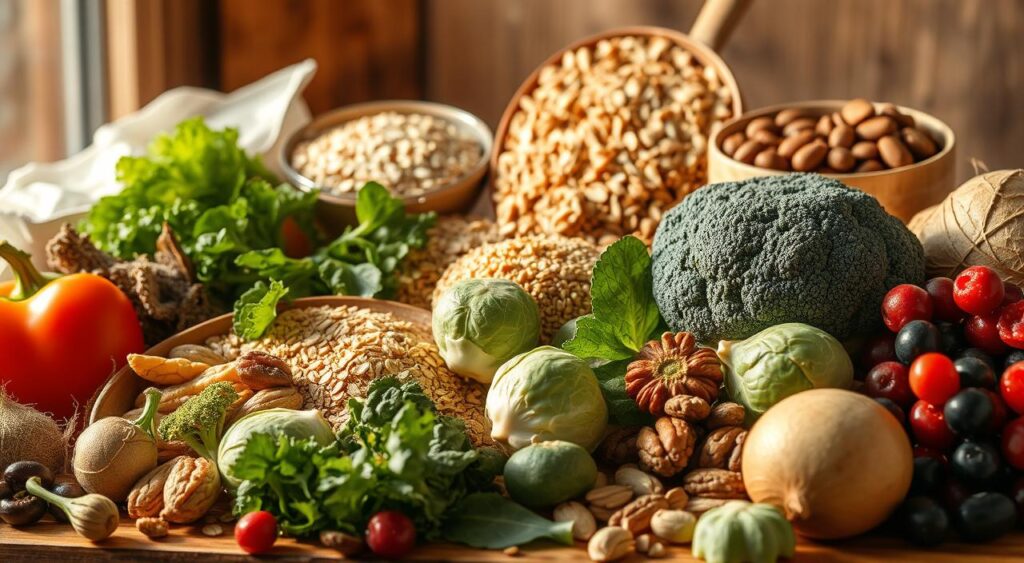
Why Fiber Helps
Soluble fiber forms a gel in your gut that slows digestion. This helps lower cholesterol, cuts cravings, and feeds gut bacteria. These bacteria are linked to better insulin sensitivity.
Vegetable and fruit fiber, plus beans and intact whole grains, slow glucose spikes. They improve glycemic control. Aim for cereals and breads with at least 3 grams of fiber per serving to boost results.
Best Sources You Can Use
High-fiber choices include almonds, black beans, broccoli, lentils, and oatmeal. Whole fruits and vegetables should be your go-to. Skip canned fruit in syrup and limit juice and large portions of dried fruit.
Soluble-fiber rich foods such as oats, flaxseeds, apples, citrus, and many vegetables belong in your meal plan. Try adding legumes to salads, switching to steel-cut or rolled oats, and sprinkling ground flaxseed on yogurt.
Your practical insulin resistance recipes can follow simple swaps. Replace refined cereals with high-fiber options, include a vegetable with every meal, and use beans as a protein-and-fiber base. Boosting fiber toward 50 grams a day can help balance blood sugar and support weight goals.
The Impact of Protein
Protein is key in any meal plan for insulin resistance. It helps keep blood sugar stable after eating. It also supports muscle repair and keeps you full between meals.
Make sure to include a lean protein at every meal and snack. Aim for about 3 oz of fish, chicken, turkey, or pork loin. Or, have 1 cup of low-fat cottage cheese. Adding fatty fish like salmon or sardines twice a week boosts your omega-3 fats, which are good for your metabolism.
Plant proteins like beans, lentils, and tofu are great for variety. They also have fiber, which slows digestion and lowers blood sugar. Try using them in recipes like lentil stews or chickpea salads for steady energy.
Limit high-fat meats like beef, lamb, and pork. Instead, choose leaner options like skinless poultry, egg whites, tuna, and lean pork. Low-fat deli meats can be good for snacks, but always check the labels for sodium and fillers.
Pairing protein with carbs can help lower blood sugar after meals. Combining a small amount of whole grains, veggies, or fruit with protein slows digestion. This helps insulin work better and fits well into a balanced meal plan for insulin resistance.
If you do weightlifting or resistance training, make sure to get enough protein. This helps your muscles take up glucose better. Over time, this improves your insulin sensitivity and helps control blood sugar better.
Here are some tips: always include a lean protein on your plate, eat fatty fish twice a week, and mix up plant-based proteins in your meals. Use simple recipes that combine beans or lentils with veggies and lean fish or poultry. This way, you can make the best foods for insulin resistance a regular part of your diet.
Timing Your Meals
Timing your meals can keep your blood sugar steady and make your day easier. Small, consistent habits can make a big difference. Try to find patterns that fit your life, not strict rules that stress you out.
The Importance of Regular Eating Patterns
Eating at regular times, like every 3–4 hours, helps avoid big blood sugar and insulin swings. Spread out carbs throughout the day to avoid spikes. This is a practical way to improve insulin sensitivity.
Make sure each meal has protein, fiber, and complex carbs. This mix slows down digestion and keeps blood sugar stable. Try lean protein, non-starchy veggies, and whole grains or legumes for a balanced meal.
Don’t skip meals. Skipping breakfast or lunch can lead to overeating and more belly fat, which makes insulin resistance worse. Eating regularly keeps your energy steady and supports long-term health.
Listening to Your Body’s Hunger Cues
Listen to your body’s hunger signals, not just habit or boredom. Eat when you’re truly hungry and stop when you’re full. This is a key skill for managing insulin resistance.
Try moving after meals, like a 15-minute walk, to lower blood sugar. Exercise boosts insulin sensitivity for hours, so walking after eating is extra beneficial. Pairing meals with movement helps you figure out the right portions and foods.
Consult a registered dietitian nutritionist for a personalized plan. They can help you adjust carb intake and create a meal plan that fits your goals and lifestyle.
Staying Hydrated
Drinking enough water helps your metabolism and keeps blood sugar levels stable. Choose simple, unsweetened drinks to help with your insulin resistance diet.
Start with plain water. Sparkling water and unsweetened herbal or green tea are good alternatives to sugary drinks. Green tea has EGCG, which can improve insulin sensitivity.
Be careful with milk and smoothies because they can add carbs. An 8-oz serving of milk counts as carbs. So, include it in your meal and snack plans. Avoid sugary drinks like soda and iced teas to prevent weight gain and insulin resistance.
Apple cider vinegar might slow down how fast food leaves your stomach and lower blood sugar. But, talk to your doctor before using it. If okayed, mix one tablespoon in a large glass of water before meals.
Practical tips you can use today:
- Carry a refillable water bottle and set hourly sips as a habit.
- Choose unsweetened green tea or herbal blends instead of sweetened beverages.
- Use sparkling water with a splash of lemon or lime for variety.
- Measure milk and smoothies so they fit your insulin resistance diet goals.
- Discuss diluted apple cider vinegar with your provider before regular use.
Combine these drinks with balanced meals and recipes that are high in fiber, protein, and healthy fats. Making small changes in hydration is a simple way to manage insulin resistance every day.
The Influence of Physical Activity
Regular movement changes how your body handles glucose. Short activities can move sugar into muscle cells for energy. This lowers insulin demand. Make exercise a daily habit for lasting benefits.

How Exercise Improves Insulin Sensitivity
Exercise makes muscles use glucose right away. This reduces blood sugar spikes and boosts insulin efficiency for hours. You can see improvements in just one workout and they last from 2 to 48 hours.
Resistance training increases muscle glucose uptake by building lean mass. Cardio improves circulation and burns belly fat, which helps insulin work better. Mixing both types of exercise gives the best results.
Types of Exercise Beneficial for You
Begin with brisk walking, cycling, or swimming if you’re new to exercise. These activities meet the AHA’s 150 minutes of moderate activity weekly. They’re also easy to fit into short sessions.
Include strength training 2–3 days a week with bands, free weights, or bodyweight exercises. Add 10–20 minute walks after meals to lower glucose spikes. This helps you make steady progress on an insulin resistance weight loss plan.
Create a simple exercise routine that includes aerobic, strength, and active recovery days. Always check with a healthcare provider if you have concerns before starting. Small, consistent steps are the best way to improve insulin sensitivity.
Monitoring Your Progress
Tracking your progress is key to seeing what works and where to make changes. Start with simple steps you can follow each week. Small, steady changes give clearer feedback than quick fixes.
Tracking Nutritional Intake
Keep a food diary or use an app to log your meals, carbs, fiber, and activity. This helps you build a reliable meal plan for insulin resistance. It also lets you compare brands for fiber and carbs.
Working with a registered dietitian nutritionist (RDN) is a good idea. An RDN can create a personalized meal plan for you. They can also help with grocery lists and goal setting. Many insurance plans, including Medicare, may cover nutrition visits.
Do a short weekly review to spot trends. Note your servings of vegetables, whole grains, and protein. Watch your fiber and refined carb intake to meet your goals.
Keeping an Eye on Blood Sugar Levels
Follow your clinician’s advice for fasting glucose and HbA1c checks. These lab values show long-term changes. They help you measure the impact of your diet.
Some people find home glucose monitoring helpful. It shows how specific meals affect your blood sugar. Share your logs with your healthcare team or RDN to fine-tune your meal plan.
Track your body weight and waist circumference over months, not days. Use apps to compare trends and see how different foods affect you. Practical tools and consistent records make managing insulin resistance easier.
For a helpful starting plan, check out this resource on creating a structured eating approach: meal plan for prediabetes reversal.
Tips for Dining Out
Eating out can be tough when you’re on an insulin resistance diet. But, with a few simple tips, you can stay on track. Making smart choices at restaurants can help you reach your goals.

Try the plate method when you can. Ask for extra veggies, cut starchy sides in half, or box half your meal before eating. Opt for grilled or baked proteins like salmon or chicken instead of fried ones.
Check out menus online before you dine. This way, you can pick a dish that fits your diet plan. Look for whole-grain options or skip bread and refined carbs to keep your blood sugar stable.
Making Smart Choices at Restaurants
- Request sauces and dressings on the side to control your portions.
- Ask the chef to use olive oil or steam veggies instead of butter.
- Choose salads with lean protein but watch the high-calorie toppings and creamy dressings.
- Swap fries or chips for a side salad or extra greens.
Being Mindful of Portion Sizes
Many restaurants serve large portions, often high in sugar and saturated fat. Share an entrée, order an appetizer as your main, or box half right away.
Drink water or unsweetened tea instead of soda or sweetened coffee. Cutting down on sugary drinks is a great way to manage insulin resistance.
Make simple swaps from your favorite recipes when cooking at home. Doing this while dining out makes it easier to stick to your diet. It also makes social meals less stressful.
Seeking Support
Changing your eating and activity habits is easier with help. Get advice from professionals and encouragement from friends. Small steps add up when you follow an insulin resistance diet and try new recipes.
Building a Support Network
Share your goals with family and friends for their support. Ask a partner or friend to help with grocery shopping and meal prep. Having someone to hold you accountable makes it easier to stick to your plan.
Look for local diabetes prevention programs and community groups. Online forums and social media groups are also great when you can’t find in-person groups. Getting support helps you keep up with new habits.
Consulting with Nutritionists or Dietitians
Registered Dietitian Nutritionists (RDNs) can create a meal plan for you. They teach you how to shop for groceries and cook in bulk. Many insurance plans and Medicare cover these visits, so check your coverage.
Before starting supplements like chromium or magnesium, talk to your doctor. They can tell you if they’re safe with your medications. Bring a list of your medications and habits to your appointment for better advice.
Here’s what you can do today: book an appointment with an RDN, ask your doctor about local resources, join a support group, and find someone to help with meal prep. These steps will help you stay on track with your insulin resistance diet and enjoy tasty recipes.
Overcoming Challenges
Making lasting changes is tough at first. You’ll face cravings, busy days, and old habits. But, small steps, clear goals, and tools make it easier.
Common Obstacles to a Healthy Diet
Sugar cravings and processed snacks can derail your progress. Stress or tiredness might make you reach for treats. Skipping meals can lead to low energy and blood sugar swings.
Portion creep from foods like nuts and avocado can slow weight loss. Social eating and busy schedules make meal prep hard. Poor sleep and stress weaken the benefits of healthy eating.
Strategies for Staying on Track
Plan meals with simple prep. Cook easy recipes like Greek yogurt parfaits and roasted vegetable bowls. This saves time during the week.
Keep healthy snacks like almonds and fruit ready. Measure foods to avoid overeating. Celebrate small wins, like adding a vegetable a day.
Use tools like grocery lists and reminders for meals. Try stress-management habits like short walks or meditation. These help with sleep and insulin sensitivity.
| Challenge | Practical Fix | Why It Helps |
|---|---|---|
| Sugar cravings | Swap with fruit + nut butter or Greek yogurt | Provides fiber and protein to stabilize blood sugar |
| Portion creep | Use measuring cups and single-serve containers | Controls calories while keeping healthy fats and flavor |
| Busy schedule | Batch-cook insulin resistance recipes and freeze portions | Ensures balanced meals when time is limited |
| Social eating | Eat a small snack beforehand and choose grilled or vegetable sides | Reduces overeating and supports better choices |
| Stress and poor sleep | Short daily walks, consistent sleep schedule, mindfulness | Improves appetite control and insulin sensitivity |
| Lack of accountability | Work with an RDN or join a structured program | Provides guidance and helps you stick to an insulin resistance weight loss plan |
Before starting supplements, talk to your doctor. Avoid crash diets. A gradual approach keeps you motivated for long-term success.
Use these tips to manage insulin resistance with practical habits. Small wins will strengthen your routine over time.
Creating Lasting Changes
Making small, steady changes is better than big fixes. Start with tiny, measurable steps that fit your life. These habits should touch your diet, sleep, stress, and movement.
Setting Realistic Goals
Choose short-term goals that are clear and easy to track. For example, walk for 15 minutes after dinner five times a week. Or, swap one sugary drink for water each day. Adding two servings of vegetables daily is also a good start.
If you’re overweight, aim to lose 7–10% of your weight. This can lower your diabetes risk. Use a simple plan for food changes. Follow an insulin resistance weight loss plan that includes whole grains, legumes, lean fish, and low-fat dairy. You can find practical meal ideas at insulin resistance diet guidance.
The Importance of Consistency
Track sleep, stress, exercise, and meals together. Non-diet factors also affect blood sugar. Aim for about 150 minutes of moderate activity each week. Keep portion control steady. Small actions repeated become lasting habits.
Create a review schedule. Check your goals monthly, note what worked, and adjust as needed. This helps you stay on track with an insulin resistance weight loss plan. You’ll also learn how to improve insulin sensitivity over time.
- Short-term goal: 15-minute walk after meals, 5 days/week.
- Nutrition swap: replace refined grains with whole grains and add legumes twice weekly.
- Behavioral target: consistent bedtime and stress check-ins twice weekly.
Conclusion: Your Path to Better Health
You now have a clear roadmap for tackling insulin resistance. It starts with an insulin resistance diet. Focus on eating non-starchy vegetables, whole grains, legumes, lean protein, and healthy fats. Also, don’t forget to include fiber.
Reduce your intake of added sugars, refined carbs, processed foods, and trans fats. These foods can make insulin resistance worse.
Combine food changes with regular exercise and rest. Aerobic activities and strength training help your body use glucose better. This reduces your need for insulin.
Don’t forget to manage stress, get enough sleep, stay hydrated, and control your portions. These steps work together to help manage insulin resistance.
Keep track of your progress with weight, waist measurements, fasting glucose, or HbA1c. Your healthcare provider will guide you. Use apps or food logs to stay on track and adjust meal times to fit your schedule.
Before trying supplements, talk to a registered dietitian nutritionist or clinician. Keep learning about improving insulin sensitivity from trusted sources.
Small, consistent changes can make a big difference. Build balanced meals, try new recipes, and stick to an exercise plan you like. With effort and support, you can improve your metabolic health and continue on your path to better health.

